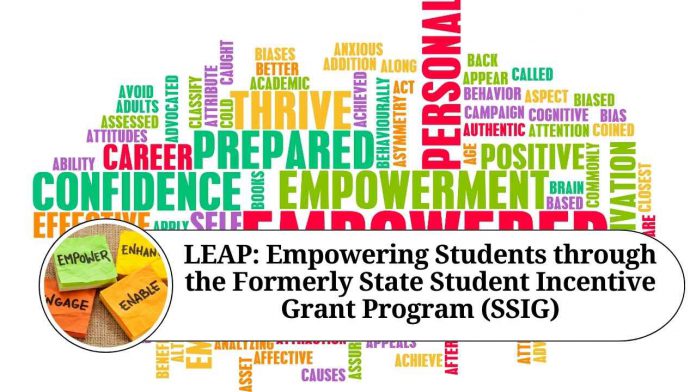Introduction
In an increasingly competitive world, access to quality education has become a vital factor in shaping a successful future. However, the rising costs associated with higher education can often pose significant obstacles for aspiring students. To address this issue, many governments and institutions have established financial aid programs to ensure that deserving students can pursue their academic dreams without being hindered by financial constraints. Among these initiatives, the Formerly State Student Incentive Grant Program (SSIG), now known as LEAP, has emerged as a beacon of hope for countless students striving to overcome financial barriers and access higher education.
What is LEAP?
LEAP, an acronym for Leveraging Educational Assistance Partnership, was formerly recognized as the State Student Incentive Grant Program (SSIG). It is a federal program that operates in collaboration with state governments to provide need-based financial aid to undergraduate students pursuing postsecondary education. LEAP aims to expand access to higher education by supplementing the resources available to students who demonstrate exceptional financial need.
Supporting Educational Dreams:
The primary objective of LEAP is to ensure that financial limitations do not prevent talented and deserving students from pursuing their educational goals. Through this program, eligible students can receive financial assistance that can be used to cover various educational expenses, such as tuition fees, books, supplies, and other essential costs associated with higher education. By alleviating the financial burden, LEAP empowers students to concentrate on their studies and make the most of their academic opportunities.
Collaboration with State Governments:
LEAP operates in close collaboration with state governments across the United States. Each state receives a federal allocation of funds, which is then matched by state funds. The total amount is subsequently distributed to eligible institutions within the state, which, in turn, award grants to eligible students. The collaboration between federal and state entities ensures a more comprehensive and localized approach to providing financial aid, tailoring the support to the specific needs and circumstances of each state’s student population.
Eligibility and Application Process:
Eligibility criteria for LEAP grants may vary from state to state, but typically include factors such as financial need, enrollment status, and academic progress. Students are required to complete the Free Application for Federal Student Aid (FAFSA), which serves as the primary application for most federal and state financial aid programs. It is crucial for students to submit the FAFSA as early as possible to maximize their chances of receiving LEAP grants, as funds are often distributed on a first-come, first-served basis.
The Impact of LEAP:
Over the years, LEAP has had a transformative impact on the lives of countless students. By easing the financial burden, the program has enabled students from diverse backgrounds to pursue higher education and achieve their academic aspirations. LEAP grants have not only helped students access education, but they have also played a significant role in reducing student loan debt, making education more affordable and sustainable in the long run.
Conclusion
LEAP, formerly known as the State Student Incentive Grant Program (SSIG), is a commendable initiative that has paved the way for numerous students to overcome financial obstacles and pursue their educational dreams. By collaborating with state governments, LEAP provides crucial financial assistance to students in need, opening doors to higher education and creating a brighter future. As the program continues to evolve, it is essential for students to remain aware of its benefits and seize the opportunities it offers to shape their educational journey. Through LEAP, the pursuit of knowledge becomes a reality for many, ensuring a more equitable and promising society for all.
Read more useful content:
Frequently Asked Questions (FAQs)
Q: What is LEAP?
A: LEAP stands for Leveraging Educational Assistance Partnership. It is a federal financial aid program that was formerly known as the State Student Incentive Grant Program (SSIG). LEAP provides need-based grants to undergraduate students to help them access and afford higher education.
Q: How does LEAP work?
A: LEAP operates in collaboration with state governments. The federal government allocates funds to each state, which are then matched by state funds. The total amount is distributed to eligible institutions within the state, and they award grants to eligible students based on their financial need and other criteria.
Q: Who is eligible for LEAP grants?
A: Eligibility criteria for LEAP grants may vary from state to state. However, generally, students must demonstrate financial need, be enrolled or accepted in an eligible postsecondary institution, and meet other requirements set by their state’s LEAP program. Completing the Free Application for Federal Student Aid (FAFSA) is typically required to determine eligibility for LEAP grants.
Q: What expenses can LEAP grants cover?
A: LEAP grants can be used to cover various educational expenses, including tuition fees, books, supplies, and other essential costs associated with higher education. However, the specific expenses covered may vary depending on the guidelines established by each state’s LEAP program.
Q: How can I apply for LEAP grants?
A: To apply for LEAP grants, students must complete the Free Application for Federal Student Aid (FAFSA). The FAFSA serves as the primary application for most federal and state financial aid programs, including LEAP. It is essential to submit the FAFSA as early as possible to maximize the chances of receiving LEAP grants, as funds are often distributed on a first-come, first-served basis.
Q: Are LEAP grants renewable?
A: LEAP grants are generally awarded on an annual basis, and students must reapply each year to be considered for renewal. Renewal eligibility is typically contingent upon meeting the ongoing requirements set by the state’s LEAP program, including maintaining satisfactory academic progress and demonstrating continued financial need.
Q: Can I receive LEAP grants if I already have other forms of financial aid?
A: Yes, students can still receive LEAP grants even if they are already receiving other forms of financial aid, such as federal Pell Grants or institutional scholarships. LEAP grants are designed to supplement existing aid and help students further alleviate their financial burden.
Q: How much financial assistance can I receive through LEAP?
A: The amount of financial assistance provided through LEAP grants varies depending on factors such as the student’s financial need, the availability of funds in the state, and the overall demand for aid. The specific grant amount is determined by the state’s LEAP program and may differ from state to state.
Q: Is LEAP available in all states?
A: LEAP is available in most states; however, the program’s name and specific guidelines may vary from state to state. It is important to check with the financial aid office of your chosen institution or visit the official website of your state’s LEAP program to determine the availability and requirements of the program in your area.
Q: Can LEAP grants be used for graduate or professional degree programs?
A: LEAP grants are primarily targeted towards undergraduate students pursuing their first bachelor’s degree. However, some states may offer LEAP funds for certain graduate or professional degree programs. It is advisable to check with your state’s LEAP program or financial aid office for more information regarding the eligibility of graduate-level programs.




















